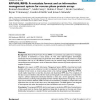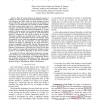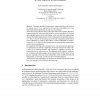1368 search results - page 39 / 274 » Understanding Software Systems Using Reverse Engineering Tec... |
BMCBI
2008
2008
RPPAML/RIMS: A metadata format and an information management system for reverse phase protein arrays
13 years 9 months ago
Background: Reverse Phase Protein Arrays (RPPA) are convenient assay platforms to investigate the presence of biomarkers in tissue lysates. As with other high-throughput technolog...
WCRE
2009
IEEE
14 years 3 months ago
2009
IEEE
—Much of modern software development consists of building on older changes. Older periods provide the structure (e.g., functions and data types) on which changes in future period...
CAISE
2003
Springer
14 years 2 months ago
2003
Springer
This paper presents a requirements engineering framework based on the notions of Actor, Goal, and Intentional Dependency, and applies it to a case study in the field of Informatio...
SIGSOFT
2007
ACM
14 years 9 months ago
2007
ACM
Code clones are similar code fragments that occur at multiple locations in a software system. Detection of code clones provides useful information for maintenance, reengineering, ...
ICSE
2001
IEEE-ACM
14 years 1 months ago
2001
IEEE-ACM
It has long been accepted that requirements analysis should precede architectural design and implementation, but in software evolution and reverse engineering this concern with bl...



